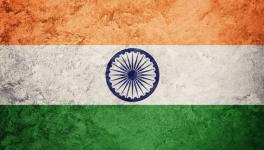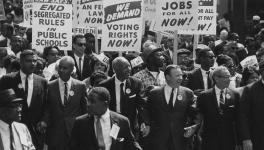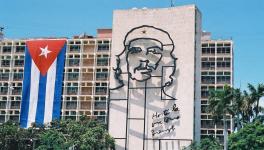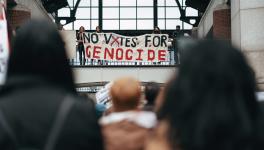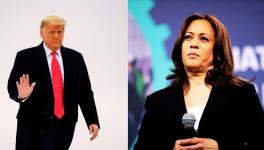Modi in America: Protests Indian Media Buried under Propaganda
A large section of the mainstream Indian media ran a boisterous campaign supporting Prime Minister Narendra Modi during his four-day visit to the United States. Their pet theme was that the Prime Minister got a warm welcome from the people of Indian origin in the American cities he visited. Repeated telecast of such news prompted me to call Amarveer Singh, a Punjabi journalist based in the United States. When he answered, on 24 September at 11:47 pm, I heard loud noises in the background, and some voices shouting slogans like, “Go back Modi!” “Take back Black Farming Laws!” “Down with Modi government, enemy of minorities!” “Enemies of democracy are dead!”
Amarveer stepped away from the noise to tell me he was in Washington DC to cover the anti-Modi protests. “Demonstrations are scheduled for 24 and 25 September,” he told me. “Modi will meet US President Joe Biden today. That is why this protest is taking place in Washington DC. Modi will address the United Nations General Assembly tomorrow. Accordingly, demonstrations were scheduled in New York on 25 September.”
People from all classes and ideologies got involved in these protests against Prime Minister Modi’s visit to America. “The protesters include those who lean on Khalistani ideas to liberal Sikh organisations, to Punjabis in America and Americans of South Indian origin, to Dalit organisations, Kashmiris, university students, liberals, leftists, advocates of the farmers’ movement and a few Hindu organisations. The protesters who support Khalistani ideologies are protesting separately from all the others,” Amarveer said.
While all others organisations protested together, they had issued strict instructions that no protester should bring a Khalistani or separatist flag into their demonstrations. Separatist rhetoric was not allowed either. The demonstrators carried banners that said “No Farmers No Food” and displayed farmers flags, the Indian tricolour, “Modi Go Back”, “Down with Modi”, and posters or placards that compared Modi with Hitler. When asked why they protesting, Amarveer said they broadly share similar demands and objectives. “They are raising their voices in favour of the farmers’ movement and against the agricultural laws. They are also expressing their anger against the Citizenship Amendment Act, the anti-minority, anti-Dalit and anti-tribal policies of the Modi government, the atrocities on Kashmiris, and the anti-democratic policies of the Modi government.” The Khalistani organisations were separately opposing Modi’s visit over all these issues and decried the constant pressure from the Center on Punjab other than over their own separatist issues.
Even in the past, demonstrations in favour of Indian farmers and against the policies of the Modi government have taken place in the United States, Canada, and other countries. It is why many American leaders of Indian origin have, from time to time, objected to the actions of the Modi government and its attitude towards minorities. Experts say that when United States Vice President Kamala Harris exhorted Modi during his just-ended visit to save democracy, it reflects the growing anger over the prevailing situation in India. A day before Modi met with Joe Biden, the United States Commission on International Religious Freedom (USCIRF) demanded that the United States President raise human rights violations and atrocities on minorities in India at their meeting.
Sharp outbursts against Modi’s earlier visits to the United States were also buried or suppressed by a large section of the mainstream Indian media. It either did not telecast the news or concealed it by calling the protesters “Khalistani” or “anti-India”. For example, the large-scale support from overseas Indians for the ongoing farmers’ movement is apparent from their numerous posts on social media. Dr Darshan Pal, leader of the Samyukta Kisan Morcha which is organising the anti-farm law protests in India, says the Indian diaspora in the United States and other countries openly supports the farmer’s movement. Over the past few months, non-resident Indians have held rallies and protests against these laws and other policies of the Modi government. According to Darshan Pal, the farmers have often pointed out—with evidence—that the India has been violating the rules of a 2018 United Nations declaration on the rights of farmers and others working in rural areas. Farmer leader from Uttar Pradesh Rakesh Tikait had also appealed to Indians in America to oppose Modi’s visit to the United States. He requested Biden to bring up the concerns of Indian farmers with Modi.
Over the phone, I asked a participant of one protest staged outside the White House how welcoming overseas Indians really are of Modi. This protester responded, “India’s godi media is over-playing news about the support for [Prime Minister Modi]. In fact, more people are joining our demonstrations against him. Those who are welcoming are part of the crowds that have to be brought here, and most seem to be of Gujarati origin too. People come to our demonstrations are coming on their own initiative.”
On 25 September, when Modi addressed the United Nations General Assembly, four different demonstrations were taking place outside, none of which got the attention they deserved from the pro-government media in India. Due to security reasons, the pro-Khalistan organisations, the National Overseas Congress, the pro-farmer local gurdwara committees and the protesters who arrived under the Hindus for Human Rights banner were allowed to protest only at different locations. The Indian National Overseas Congress protested against human rights abuses in India. The Gurdwara committee protesters wore green turbans to their protest against the agricultural laws. The Hindus for Human Rights protests were against the Citizenship Amendment Act, the National Register of Citizens, and the incarceration of social workers in India.
Representatives of the Council of Churches in New York also participated in these demonstrations. Dr Surender Gill, who represents 16 social and religious organisations that are protesting together, said, “We have come to protest against the anti-humanitarian attitude of the Narendra Modi government and the farmers’ struggle. We have already demonstrated thrice in front of the Indian Embassy in favour of farmers. We have been demonstrating before the White House for 65 days. Every day, five of our men stand in front of the White House carrying flags and placards opposing the [new Indian] farm laws. We want to tell the world how ruthless the government of India is, that it is not even prepared to listen to its own farmers and labourers.
In neighbouring Canada, too, the Indian fraternity staged demonstrations against Modi’s visit to the United States. Gurvinder Singh Dhaliwal, a Punjabi journalist who lives in Surrey, Canada, said over the phone, “Many from the Indian brotherhood in Canada went to participate in the demonstrations in America, but the borders are closed due to Covid-19 restrictions. That is why people held symbolic demonstrations in their own country.”
Dupender Kaur Saran, a social worker from the Canadian state of British Columbia, says, “We oppose the new farm laws and the policies of the Indian government. The Modi government has played all kinds of tricks to defame this movement, but it must face the facts: this movement has brought people together.”
The author is an independent journalist. The views are personal.
Get the latest reports & analysis with people's perspective on Protests, movements & deep analytical videos, discussions of the current affairs in your Telegram app. Subscribe to NewsClick's Telegram channel & get Real-Time updates on stories, as they get published on our website.










